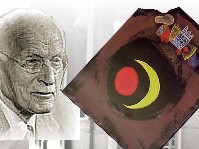|
| *NOTE: To return to my Narrative Page, click your mouse on the arrow following the definition. |
| EMDR: Eye Movement Desensitization and Reprocessing. A procedure developed by Francine Shapiro. Shapiro is said to have fortuitously "discovered this technique when she found that rapid back-and-forth eye movements reduced her own anxiety. Shapiro thereafter applied this procedure to her own clients with anxiety disorders and claims to have met with remarkable success. |
Clients are first asked to visualize the traumatic even as vividly as possible. While retaining this image in mind, they are told to supply a statement that epitomizes their reaction to it. Clients are then asked to rate their anxiety on a Subjective Units of Distress (SUDs) scale, which ranges from 1 to 10, with 0 being no anxiety and 10 being extreme terror. Following these steps, clients are asked to visually track the therapist's finger (or other object) as it sweeps rhythmically from right to left. Following each set of issues, clients are asked to "blank out" the visual image and inhale deeply, and are then asked for a revised SUDs rating. The process is continued until the client's SUDs ratings fall to 2 or lower.  |
Myoclonus: An involuntary jerking movement of the muscles of the body. The limbs and extremities are usually involved. One patient/friend of mine even has heart palpitations and involvement of the stomach muscles. The twitching movements occur normally, albeit infrequently, when some people just begin to doze off to sleep. In the myoclonic patient, the movements occur frequently and involuntarily throughout the day. These movements are most disturbing and embarassing.  |
Iatrogenic: Any adverse mental or physical condition induced in a patient by effects of treatment by a physician or surgeon. The term implies that such effect could have been avoided by proper and judicious care on the part of the physician.  |
EEG: Electroencephalography. A painless procedure for recording electrical impulses of the brain. A variety of patterns normally produced by nerve cells are altered in recognizable ways by abnormal conditions such as epilepsy. Electroencehpalography is done by placing metal plates called electrodes on the head. The electrodes are attached to a recording device that reproduces the activity graphically. The recording is call an electroencephalogram.  |
MRI: Magnetic resonance imaging (MRI) is the newest, and perhaps most versatile, medical imaging technology available. Doctors can get highly refined images of the body's interior without surgery, using MRI. By using strong magnets and pulses of radio waves to manipulate the natural magnetic properties in the body, this technique makes better images of organs and soft tissues than those of other scanning technologies. MRI is particularly useful for imaging the brain and spine, as well as the soft tissues of joints and the interior structure of bones. The entire body is visible to the technique, which poses few known health risks.  |
| |
| DECombs@attbi.com |
| |
| |
| |
|
|
